The Dell XPS 15 9550 Review: Infinity Edge Lineup Expands
by Brett Howse on March 4, 2016 8:00 AM ESTSystem Performance
The XPS 15 is offered with three processor choices. The base model is the 35-Watt Intel Core i3-6100H, which is a dual-core Skylake chip with a 2.7 GHz frequency and 3 MB of cache. While I’m sure that it’s fine for most tasks, the base model is also lacking a discrete GPU and means you are only going to be using the integrated graphics, which in this case is the HD 530. I would expect the bulk of Dell’s sales to be the Core i5 and i7 models, which also come with the NVIDIA GeForce GTX 960M graphics card. The Core i5-6300HQ is a quad-core, 45-Watt part, that runs between 2.3 and 3.2 GHz, and it has a 6 MB cache. The top option is the Core i7-6700HQ, which includes HyperThreading (the Core i5 lacks this but the Core i3 has it) and a base frequency of 2.6 GHz with a turbo frequency of 3.5 GHz. The Core i7 is the model that was provided to us for this review.
On the memory side, this device includes two SODIMM slots which is a nice bonus for upgradability. The base offering is 8 GB of DDR4-2133, and you can buy it with 16 GB as well, or if you want to add your own DIMMs you can put 32 GB in this machine. For storage, hybrid hard drives are at the low end of the device range, but Dell ramps up to PCIe based SSDs on the higher priced models. The review unit has a PM951 Samsung drive, which is the TLC version that we’ve already seen in many notebooks this year. Read speeds are generally great, but write speeds will be among the slower PCIe SSDs thanks to the TLC.
I’ve run the XPS 15 through our standard notebook suite, along with a couple of other tests as well. All laptops in the charts below are from our Notebook Bench, and if you’d like to compare the XPS 15 to any other device we’ve tested, please check it out here. The previous generation XPS 15 9530 in the charts has the Core i7-4702HQ processor, GTX 750M GPU, 3200x1800 display, and a 91 Wh battery. The Lenovo Y700 is a device that we just reviewed and has the same CPU and GPU as the XPS 15 9550, and I thought it would be interesting to also see the XPS 13 here as well, although this is the Broadwell version we reviewed last year. This is a Core i5-5200U CPU, 3200x1800 display, and 8 GB of memory.
PCMark
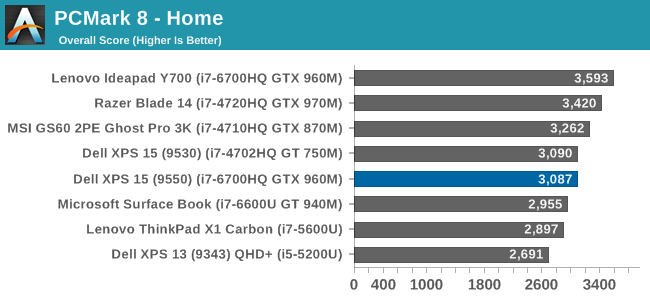
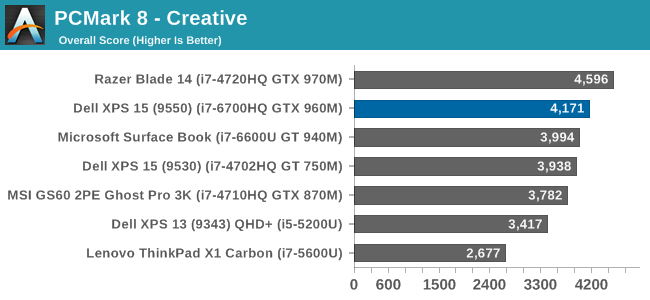
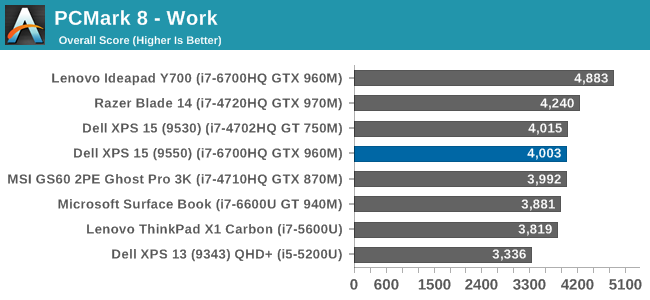
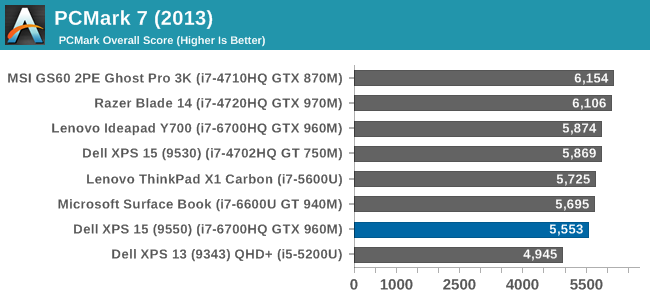
PCMark attempts to recreate actual workloads that people would use every day, and with version 8 they have several tests to focus on workloads for those tasks. Home includes web browsing, gaming, photo editing, and video chat. Creative has web browsing, photo editing, group video chat, transcoding, and some gaming, and Work has document editing, spreadsheets, and video chat. Pretty much all aspects of the device are tested, and even things like the display resolution can impact the score. The UHD resolution on the review unit impacts these scores quite a bit in fact, with the XPS 15 often quite low compared to the Lenovo Y700 which has the same CPU and GPU but a 1920x1080 display.
Cinebench
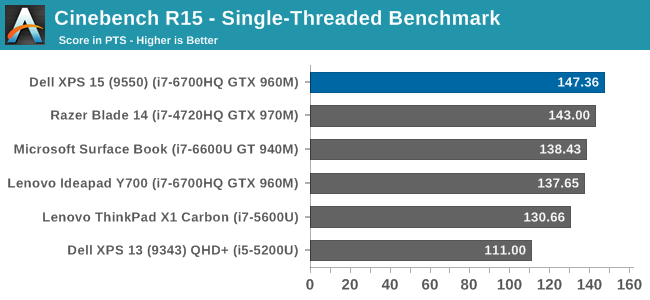
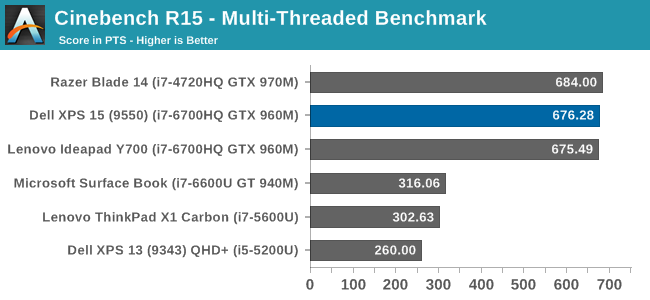
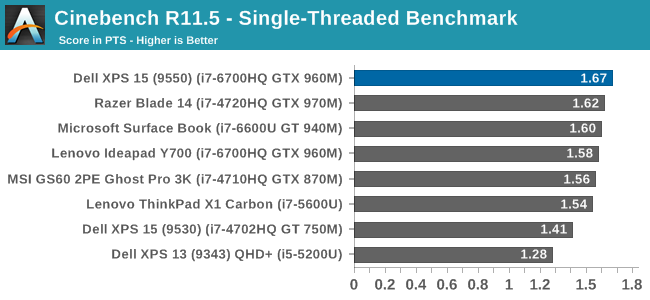
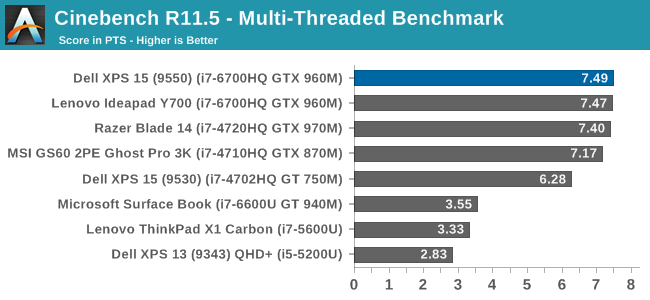
Cinebench is a CPU heavy workload which renders an image. It can use all cores and likes more MHz as well. Just like the Lenovo Y700, I found the XPS 15 wasn’t a big jump in performance with Skylake compared to Broadwell and even some of the later Haswell Core i7 parts. It is however a sizeable jump over the outgoing XPS 15 9530.
x264

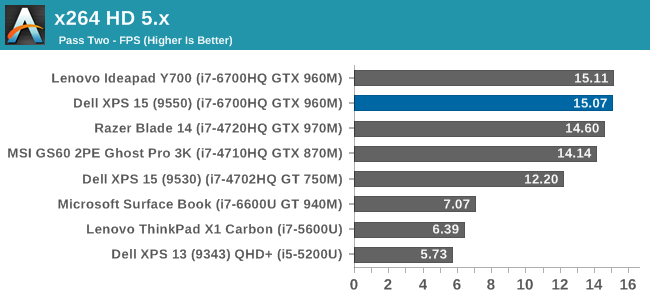
This test does video transcoding, and much like Cinebench is strongly influenced by CPU performance. More cores and higher frequencies are the name of the game here. Just like Cinebench, there also isn’t an increase in performance with Skylake on these tests compared to Broadwell or later generation Haswell chips like the i7-4720HQ, which can turbo up to 3.6 GHz compared to 3.5 GHz on the i7-6700HQ. But it is still a big jump over the i7-4702HQ found in the XPS 15 9530.
Web Tests
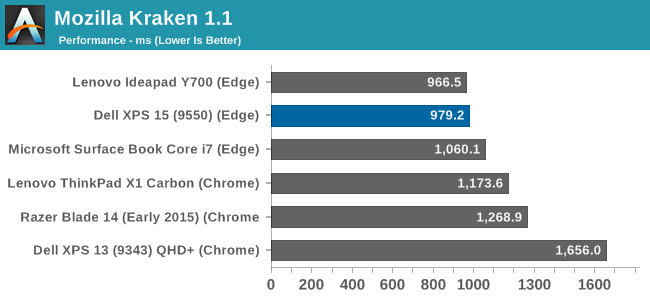
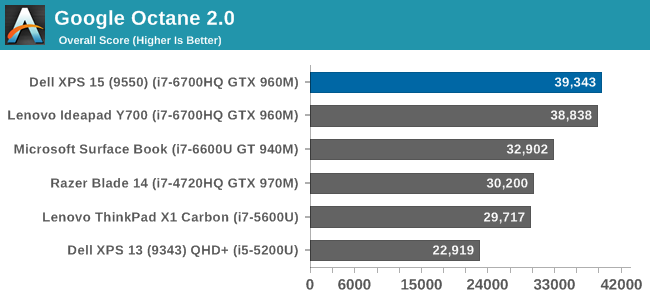
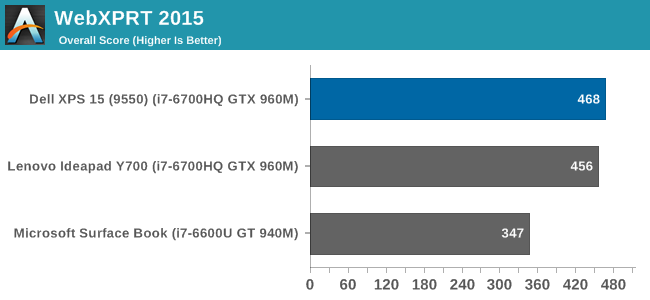
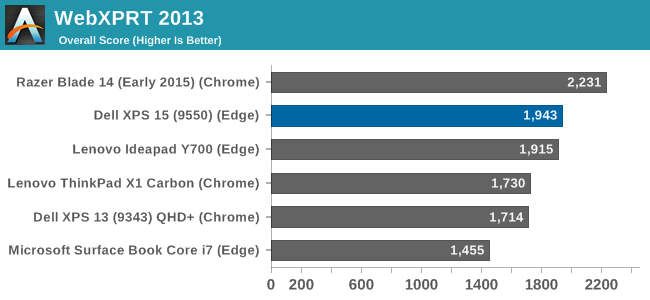
I’ve mentioned this a few times already but its worth repeating. Since the launch of Windows 10, we’ve switched from using Google Chrome for web testing to Microsoft Edge. Edge has performance that is quite a bit closer to Chrome now, surpassing it in some tests and behind in others, but both are capable browsers. As such, I’ve labeled the older laptops to let you know which browser was used at the time they were tested.
With a quad-core Skylake processor, which now supports Intel’s Speed Shift technology, the XPS 15 scores very well in our web results. The bursty nature of the web tests really plays into the hands of Speed Shift and lets the processor quickly get up to maximum frequency to perform the task, and make for a more responsive browsing experience.










152 Comments
View All Comments
Ryan Smith - Monday, March 7, 2016 - link
We've checked, and there's only a single drive (and not a RAID device) present in the Windows device manager.Soac - Wednesday, March 9, 2016 - link
I don`t think I have explained correctly. The Laptop came setup in RAID mode on the BIOS, from the forums I saw that it happened to everyone, and yes this is for the 1 single drive 512 samsung m.2. Hence why I said it didn`t make sense. However, if you change the BIOS setting to AHCI the read speeds go up to 1.7Gbps.-----------------------------------------------------------------------
CrystalDiskMark 5.0.3 x64 (C) 2007-2015 hiyohiyo
Crystal Dew World : http://crystalmark.info/
-----------------------------------------------------------------------
* MB/s = 1,000,000 bytes/s [SATA/600 = 600,000,000 bytes/s]
* KB = 1000 bytes, KiB = 1024 bytes
Sequential Read (Q= 32,T= 1) : 1723.554 MB/s
Sequential Write (Q= 32,T= 1) : 600.373 MB/s
Random Read 4KiB (Q= 32,T= 1) : 0.000 MB/s [ 0.0 IOPS]
Random Write 4KiB (Q= 32,T= 1) : 0.000 MB/s [ 0.0 IOPS]
Sequential Read (T= 1) : 0.000 MB/s
Sequential Write (T= 1) : 0.000 MB/s
Random Read 4KiB (Q= 1,T= 1) : 0.000 MB/s [ 0.0 IOPS]
Random Write 4KiB (Q= 1,T= 1) : 0.000 MB/s [ 0.0 IOPS]
Test : 1024 MiB [C: 21.6% (102.8/476.4 GiB)] (x5) [Interval=5 sec]
Date : 2016/03/09 23:13:32
OS : Windows 10 [10.0 Build 10586] (x64)
Funny enough, someone was saying that in RAID mode the drive felt faster... so it would be cool if you could test it.
medi03 - Sunday, March 6, 2016 - link
Would be interesting to see how it fares at gaming vs amd's carrizo notebooks.iks - Sunday, March 6, 2016 - link
While this is surely a great piece of tech, with a superb screen, capable hardware, and decent, cooling I still wonder, what is the target audience of this and other similar devices? Have the guys over at Dell and other companies actually tried to do productive work that involves a lot of typing on this so-called "keyboard"? Especially programming? Using impossible to hit buttons with no proper spacing, a short F row, minuscule arrows and no dedicated page up / page down / home / end. Sorry, but a keyboard like that is just dumb, and a torture to use.nerd1 - Sunday, March 6, 2016 - link
Say that to millions of mac users. Apple's DESKTOP keyboard is even worse than this.BPB - Monday, March 7, 2016 - link
I am a developer, and I use a company issued Dell at work (decent specs). The keyboard doesn't matter to me since I dock it at work. At home I leave it closed and plug a monitor/keyboard/mouse into it. So why should I care? I do occasionally use it by itself, but I don't mind since it's not very often. I guess what I'm saying is, how many developers use a notebook without plugging in peripherals?iks - Thursday, March 10, 2016 - link
Well, I'm learning to use Vim to overcome button limitations on the different keyboards I may get to work on in future. People work on 60% boards after all.As far as plugging peripherals in / out, aren't you afraid of the ports coming loose over time?
jasonelmore - Monday, March 7, 2016 - link
I wanted to point out that the laptop on this article has different materials depending on if you get the 1080p version vs the 4k version.The 1080p version has a lot more plastic vs the 4k one.
nerd1 - Monday, March 7, 2016 - link
1080p version lacks the glossy glass (which I hate), but it is identical elsewhere.rstuart - Monday, March 7, 2016 - link
I own one of these, but I run Linux. Typical Linux issues - if enable the NVidia card it doesn't boot, and it will be because NVidia hasn't released drivers for it yet. I'm mostly a command line user, so that doesn't worry me overly. The Intel drivers causing the kernel to crash 2 out of 3 boots on the other hand drove me nuts. The latest kernel has fixed that thank god, so it's rock solid now. I was surprised to read people running Windows are having the similar issues - here I was putting it down to Intel's poor support for Linux. It's more of a case of Intel not having good drivers, at all, on anything. Be patient, and be forgiving of Dell - it's Intel's problem, not Dell's.Apart from the display, it works extraordinarily well out of the box. As a Linux user, this is not something I'm used to. On the down side, there is not much in the box as Dell hasn't got their act together yet accessories - mostly because of the change to USB-C.
The one thing I do question myself about is going with the UHD display. It is gorgeous. But according to Dell the HD display roughly doubles the battery life, and in reality eye candy fade but not having to worry about charging during the day would have been appreciated for a long, long time.
One other feature not mentioned in the review is everything (battery, WiFi card, DIMM's, HDD/SSD, fans for cleaning) is accessible with the removal of 8 or so easy to find screws on the back. Unlike some other makes, Dell laptops have been getting better in this regard over the years.